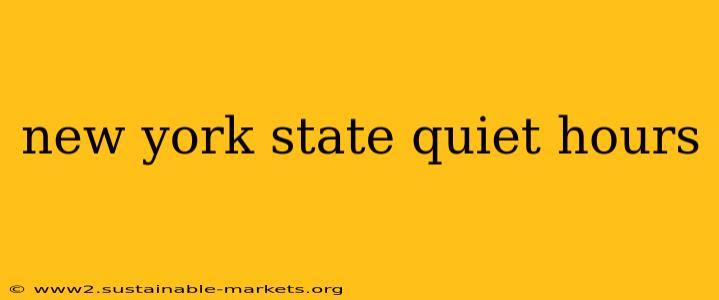Living in New York State means navigating a vibrant and bustling environment. However, even in the heart of the city or the quietest countryside, everyone deserves a peaceful respite. Understanding and respecting New York State's quiet hours is crucial for maintaining harmonious communities. This comprehensive guide breaks down the specifics, offering clarity on local ordinances and best practices for peaceful co-existence.
What are Quiet Hours in New York State?
There's no single, statewide quiet hours law in New York. Instead, quiet hours are primarily regulated at the local level, meaning the specific times and restrictions vary significantly depending on your city, town, or village. This means that the quiet hours in New York City will be different from those in a smaller town in Upstate New York.
This decentralized approach reflects the diverse needs and character of different communities across the state. While some areas might have stricter regulations, others may have more lenient ones. It's crucial to check your local ordinances to understand the specific quiet hours applicable to your area.
How to Find Your Local Quiet Hour Ordinances
Locating your local quiet hour laws might involve a bit of detective work, but it's essential for peaceful co-existence. Here are some key steps:
-
Check Your Municipality's Website: Most towns, villages, and cities have official websites outlining local laws and ordinances. Search for terms like "noise ordinances," "quiet hours," or "noise pollution control."
-
Contact Your Local Government: If you can't find the information online, call your town hall, village hall, or city hall. Their staff should be able to direct you to the relevant documentation or provide details over the phone.
-
Review Your Lease or Rental Agreement: If you rent your property, your lease agreement might include specific clauses regarding noise levels and quiet hours that supersede the general local ordinances.
Common Quiet Hour Restrictions Across New York State
While specific times vary, many localities in New York State enforce quiet hours typically between 10 PM and 7 AM. However, some areas might extend these hours or have different restrictions on weekends or holidays. These restrictions often cover:
- Loud noises: This includes loud music, shouting, construction work, and any other activities that generate excessive noise.
- Vehicle noise: Excessive honking, revving engines, and loud exhaust systems are frequently targeted.
- Construction activities: Many municipalities restrict or prohibit noisy construction projects during quiet hours.
What to Do if Noise Violations Occur
If you are disturbed by excessive noise during quiet hours, the first step is usually to politely address the issue with your neighbor. If this proves unsuccessful, you can:
- Contact Your Local Police Department: They are the primary enforcement authority for noise violations. They can investigate complaints and issue warnings or citations if necessary.
- File a Formal Complaint: Your local government likely has a process for filing formal noise complaints. This usually involves providing details about the incident, including date, time, and the nature of the disruptive noise.
Beyond the Law: Promoting Peaceful Neighborhoods
While understanding and adhering to quiet hour laws is vital, fostering a peaceful neighborhood extends beyond legal requirements. Consider these proactive measures:
- Communicate Respectfully: Open communication with neighbors about noise levels can prevent conflicts before they arise.
- Be Mindful of Noise Levels: Practice good neighborly behavior by being considerate of the sounds you create.
- Soundproof Your Home (if possible): Investing in soundproofing can reduce noise pollution both coming into and going out of your home.
This guide provides a general overview of quiet hours in New York State. Remember, always refer to your local ordinances for the precise regulations in your area. By understanding and respecting these laws, we can all contribute to creating more peaceful and harmonious communities across the state.

